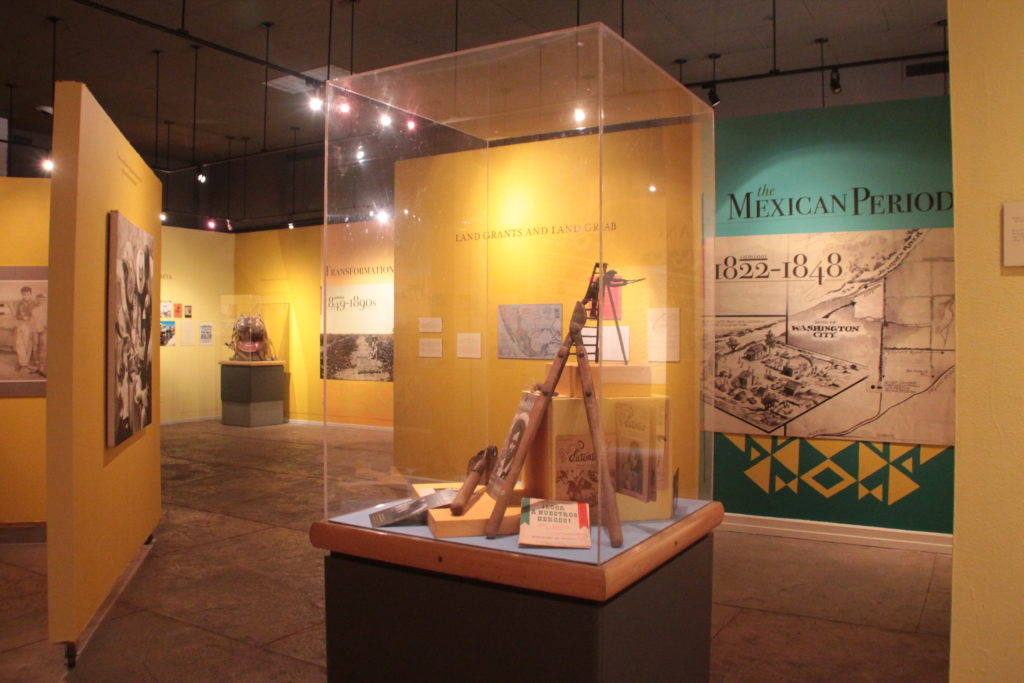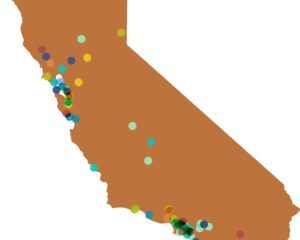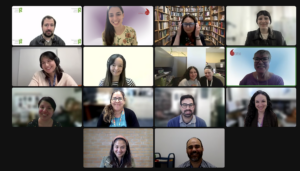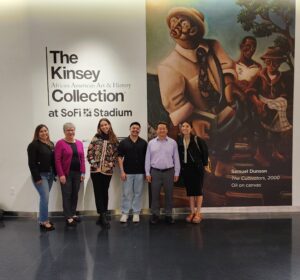In the heart of downtown Fresno sits a lovely casa de la cultura, rich with Central Valley history. Arte Américas, currently the Valley’s largest non-profit Latino cultural center, opened more than 30 years ago, and moved into its current building in 1995, with 10,000 square feet of performance, meeting, classroom, and gallery space, as well as an adjacent and beautifully landscaped plaza which is host to many outdoor events including summertime concerts. In these galleries now is an exhibition well-worthy of the cultural heritage of this building, CAMINOS: Latino History of the Central Valley. A nearly exhaustively researched installation, the exhibit spans two large gallery spaces, and eight historic periods of California’s history, from the first contact between Spanish settlers and indigenous peoples, through today. Intermixed are oral history interviews, artifacts, original artwork, videos, maps, and much more, bringing to life the rich and complex legacy of this region and its many peoples. We had a chance to speak with Project Manager Nancy Márquez about what it took to make the exhibition happen, how it’s been received, and what’s next for the show—spoiler alert; it’s already been extended from its original end date of June 30 through the end of August.
California Humanities: What is your project?
Nancy Márquez: Our project began as a simple idea, an exhibit of the history of Latinos in the Central San Joaquin Valley. Since CAMINOS is Spanish for roads, paths, journeys, it is aptly titled. It turned out to be not so simple—it took us on a path to explore and document our history, after 30 years as an arts center.
“Seeing the history of my people here in my Fresno is so important. Thank you!”
|
CH: Why did you do this exhibition and what did you hope to accomplish?
NM: In 2017, there was a display of Fresno County’s history at the Fairgrounds with almost no Latino presence. Our initial shock turned into a challenge that we undertook. A former board member and community leader, retired Judge Armando Rodriguez, used his connections to get us started. He died before the exhibit was realized, but his desire to tell this story resonated with many people born in the 1930s, 1940, and 1950s, who experienced struggles and changes during their lifetimes. Several of them also died during the last few months before the exhibit was installed. The project became a promise, especially to this older generation, to tell the story to future generations.
“Thank you for this wonderful space of learning, history, and art. This was an unforgettable first visit for me.”
|
CH: What was the process like of putting CAMINOS together?
NM: Arte Américas is, in vision, an arts center. This endeavor stretched us in new directions, but still incorporated our resources and artists in both the research and design phases. To begin, we turned to the National Endowment for the Arts for our initial grant of $20,000 to gather the research and resources, and connected with Dr. Alex Saragoza, a valley native and historian then teaching at UC Berkeley—our first great asset. The second grant from California Humanities gave us the core of expenses to create the exhibit. Both grants were eventually more than matched by our local educational institutions and individuals.
The first stage was to examine and collect our own history. Arte Américas turned 30 in 2017. While we organized the valley history team, we gathered and mounted an exhibition of our photos, posters and visual materials together with text. It was a “dress rehearsal” for the current exhibit, and we asked other organizations to write up their own histories for us.
Our core research team consisted of about 20 historians, community scholars, and Fresno State University interns. We met periodically, often with Alex, and discussed, identified, and created with him the historical framework that guided the exhibit. Alex identified eight key periods, and an overall theme for each. We illuminated the framework with examples from our interviews.
The periods begin with Spanish Alta California, Mexican California, and Early American California, the older development of the valley through the 1800s into a “Garden of the Sun.” In researching these periods, we came to realize why early valley history so focuses on “Anglo” history and rarely delves into other legacies. In addition to being written by the pioneers of this period, the Mexican and native populations of the second half of the 19th century were small, decimated and surviving with what skills they had, especially the vaqueros.
From 1900-on, there was continual migration to the valley and building community. Key interview questions like “How did your family get to the valley?” revealed patterns that connected everyone to the framework. Except for more recent immigrants, most traced their families back to the Mexican Revolution or the Bracero program, two international events that became key in our story. The 1940s and 1950s planted the seeds of change that were realized in the Chicano movement of the 1960x and 1970s. We collected photos and boxes of related materials.
“I enjoyed relating the journey here to my mother as it is very similar to her story.”
|
CH: Did it take place the way you originally envisioned it?
NM: CAMINOS was well named. Along the way we had roadblocks, detours, speed bumps, and dead ends. It was a new type of experience for us. We lost two of our key personnel mid-way, including our executive director. Like a flat tire on the camino, we picked up, replaced some people, and journeyed on. By the end of 2018 we formed a new team with art installation experience. Our videographer had documented 20 hours of interviews.
We opened the exhibit in March of 2019. A tour became a camino, a walk through each period with wall text, photos, slide shows, and video demonstrating highlights from each era.
We knew that the detailed information we had collected was too much for the walls, that people spend only an average of seven seconds on any one piece, and that newer generations want interactive, high tech activities. To address this, we created, scrapbook style scenes on the walls and using a variety of visual materials. We offered programming every Sunday a Plática, a series of discussions that expanded upon sections of the exhibit. Dr. Saragoza scheduled four of them and entertained visitors with his knowledge and analysis. Our media partners, Radio Bilingüe and Vida en el Valle, gave us many of the visuals and each are a part of our Sunday programs, looking back at their own growth and years of coverage. A valley musician performed songs related to the era and reminded us that the corrido form of music is a basic storytelling vehicle.
“Dr. Alex Saragoza’s Platica, El Camino al Norte, was most enlightening and interesting as well as fun!”
|
CH: What have been the results? How many people have the exhibition and related programs reached to date?
NM: Only three months into the exhibit and we’re averaging about 2,000 visitors per month. There are 70 to 100 attendees for each of the Pláticas. When we started, we thought it would be the culmination of the two-year project. We find that it’s only a rest stop. People are still giving us “stuff,” inspired by the exhibit itself, and there are many more stories to tell, photos to collect, and people who need to see it. Already, we’ve extended the exhibit through August.
“I have been to Arte Américas a few times before, but CAMINOS was by far one of my favorites. I was really inspired by the amount of information that I learned here about the past and my personal heritage. I loved it!”
|
CH: What has been the impact on participants, visitors, and the broader community?
NM: It’s one of discovery, pride, and appreciation—all reflected in comments we collect from the visitors. Where once the valley was all native, Spanish and Mexican, by 1900 only a small percentage was. Today the “Latinx” population of the Central San Joaquin Valley is over 54%. It is also increasingly becoming multicultural, as out-marriage figures are over 50%. We suggest to our visitors: “If Latino history is not in your past—is it in your future?
And if we have been on a road trip, are we there yet? Despite all the achievements, the seeds of change in the 1940s and 1950, the movimiento of the 1960s and 1970s, despite the progress, there has been backlash—and still is. There are problems of underrepresentation and all the issues related to immigration, poverty, health, and education. Overall, the exhibit is a story of resistance and resilience.
“This is the best exhibit on Mexican American history that I’ve ever seen.”
|
CH: What are your plans for the future? Do you plan to continue or extend the exhibition?
NM: We plan to develop educational materials, workshops, and a video documentary from all our interviews and footage. It may even travel. Most of the exhibit materials can be reassembled in other Central Valley spaces and augmented there with their local stories, interviews, and photos.
—
CAMINOS is on view now through August 31 at Arte Américas, 1630 Van Ness Ave, Fresno, CA 93721. Gallery Hours are Thursday through Saturday, 11 am to 5 pm, and Sunday, 1 pm to 5 pm.





